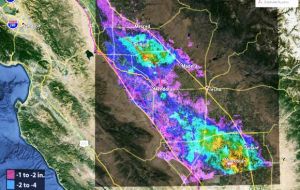MercoPress. South Atlantic News Agency
California sinking as pumping groundwater continues in response to historic drought, says NASA
 “Because of increased pumping, groundwater levels are reaching record lows -- up to 30 meters lower than previous records,” said Mark Cowin.
“Because of increased pumping, groundwater levels are reaching record lows -- up to 30 meters lower than previous records,” said Mark Cowin.  New NASA data show the sinking is happening faster, putting infrastructure on the surface at growing risk of damage.
New NASA data show the sinking is happening faster, putting infrastructure on the surface at growing risk of damage. California's Department of Water Resources released a new NASA report showing land in the San Joaquin Valley is sinking faster than ever before, nearly 5 centimeters per month in some locations, as Californians continue pumping groundwater in response to a historic drought.
“Because of increased pumping, groundwater levels are reaching record lows -- up to 30 meters lower than previous records,” said Department of Water Resources Director Mark Cowin. “As extensive groundwater pumping continues, the land is sinking more rapidly and this puts nearby infrastructure at greater risk of costly damage.”
Sinking land, known as subsidence, has occurred for decades in California because of excessive groundwater pumping during drought conditions, but the new NASA data show the sinking is happening faster, putting infrastructure on the surface at growing risk of damage.
NASA obtained the subsidence data by comparing satellite images of Earth’s surface over time. Over the last few years, interferometric synthetic aperture radar (InSAR) observations from satellite and aircraft platforms have been used to produce maps of subsidence with approximately centimeter-level accuracy.
For this study, JPL researchers analyzed satellite data from Japan's PALSAR (2006 to 2010); and Canada's Radarsat-2 (May 2014 to January 2015), and then produced subsidence maps for those periods. High-resolution InSAR data were also acquired along the California Aqueduct by NASA's Uninhabited Aerial Vehicle Synthetic Aperture Radar (UAVSAR) (2013 to 2015) to identify and quantify new, highly localized areas of accelerated subsidence along the aqueduct that occurred in 2014.
The California Aqueduct is a system of canals, pipelines and tunnels that carries water collected from the Sierra Nevada Mountains and Northern and Central California valleys to Southern California.
Using multiple scenes acquired by these systems, the JPL researchers were able to produce time histories of subsidence at selected locations, as well as profiles showing how subsidence varies over space and time.
“This study represents an unprecedented use of multiple satellites and aircraft to map subsidence in California and address a practical problem we're all facing,” said JPL research scientist and report co-author Tom Farr.
“We’re pleased to supply the California DWR with information they can use to better manage California’s groundwater. It’s like the old saying: 'you can’t manage what you don’t measure'.”
Land near Corcoran in the Tulare basin sank 33 centimeters in just eight months -- about 4 centimeters per month. One area in the Sacramento Valley was sinking approximately 1.3 centimeters per month, faster than previous measurements.
Using the UAVSAR data, NASA also found areas near the California Aqueduct sank up to 32 centimeters, with 20 centimeters of that occurring in just four months of 2014.
“Subsidence is directly impacting the California Aqueduct, and this NASA technology is ideal for identifying which areas are subsiding the most in order to focus monitoring and repair efforts,” said JPL research scientist and study co-author Cathleen Jones.
“Knowledge is power, and in this case knowledge can save water and help the state better maintain this critical element of the state’s water delivery system.” UAVSAR flies on a C-20A research aircraft based at NASA's Armstrong Flight Research Center facility in Palmdale, California.
The increased subsidence rates have the potential to damage local, state and federal infrastructure, including aqueducts, bridges, roads and flood control structures. Long-term subsidence has already destroyed thousands of public and private groundwater well casings in the San Joaquin Valley. Over time, subsidence can permanently reduce the underground aquifer water storage capacity.
“Groundwater acts as a savings account to provide supplies during drought, but the NASA report shows the consequences of excessive withdrawals as we head into the fifth year of historic drought,” Director Cowin said.
“We will work together with counties, local water districts, and affected communities to identify ways to slow the rate of subsidence and protect vital infrastructure such as canals, pumping stations, bridges and wells.”




Top Comments
Disclaimer & comment rules-

-

-

Read all commentsWhat they really need to do is find an easy way to desalinate sea water and pump it inland
Aug 21st, 2015 - 02:09 pm 0Or stop playing golf.
Aug 21st, 2015 - 03:00 pm 0Thirsty buggers, those courses.
They could do with some English weather, we have not had a summer yet.
Aug 21st, 2015 - 07:06 pm 0Commenting for this story is now closed.
If you have a Facebook account, become a fan and comment on our Facebook Page!